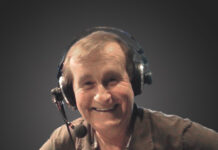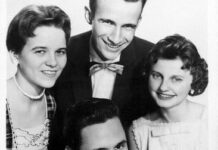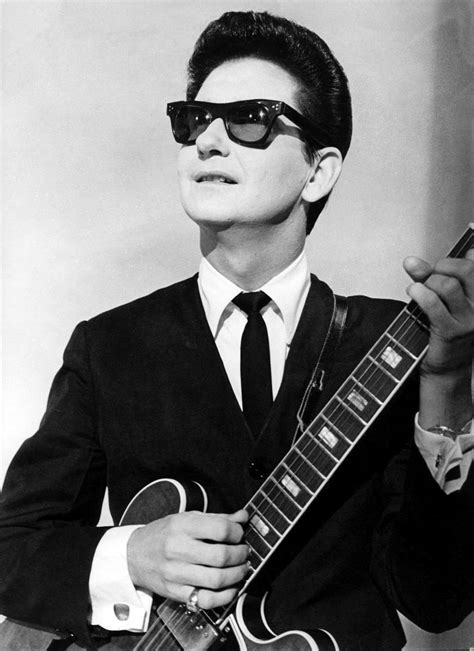How is it possible that the inane institution of the anchorman has endured for more than 60 years?

by Frank Rich, for New York Magazine April 5, 2015.
Some two months into Brian Williams’s six-month banishment from NBC for making stuff up, it’s not known whether he will ever return to the anchor chair at Nightly News. It’s also not known whether anyone cares. The understudy who stepped in, Lester Holt, is leading in evening-news viewership as Williams did. No one is complaining that Holt’s résumé includes three years co-hosting the Westminster Dog Show but lacks those narrow Indiana Jones escapes from danger, whether in Iraq or New Orleans, that his predecessor conjured up to prove his gravitas. No one is fretting about whether Holt sullied the dignity of an anchor’s higher calling when he did a cameo on 30 Rock. No one seems to notice that Holt is continuing as anchor at NBC’s Dateline, the trashy newsmagazine whose signature feature is “To Catch a Predator.”
Yet the institution of the network anchor persists even as such perennial eulogies are written for it, even as the broadcast networks give way to the individualized narrowcasting of social networks. As Andrew Heyward, the former president of CBS News, describes the atavistic absurdity of the franchise, the very concept that an anchor could “organize the world in a coherent way,” putting the world “literally” in a box for half an hour, is now a non sequitur. But like the cockroach, the anchorman has outlasted countless changes in the ecosystem around him. And he has done so despite being a ridiculous, if ingenious, American invention since his birth.
The network anchor’s roots are not in journalism but in the native cultural tradition apotheosized by L. Frank Baum. Like the Wizard of Oz (as executive-produced by Professor Marvel), anchors have often been fronts for those pulling the strings behind the curtain: governments and sponsors, not to mention those who actually do the work of reporting the news. With their larger-than-life heads looming into our living rooms, the anchors have been brilliant at selling the conceit that a resonant voice, an avuncular temperament, a glitzy, thronelike set, and the illusion of omniscience could augment the audience’s brains, hearts, and “courage” (at one point, a Dan Rather sign-off) as it tries to navigate a treacherous world. Just don’t look behind the curtain. Many of the charges leveled against Williams for conduct unbecoming an anchorman could be made against his predecessors too.
The strain of all-American humbug baked into television anchoring from the start has often been obscured by the industry’s penchant for self-mythologizing. Even the provenance of the term anchorman itself has been retouched for public consumption. For years it was said to have first gained currency in 1952, when it turned up in a CBS press release to characterize Walter Cronkite’s role in the network’s coverage of the political conventions. Also for years, Don Hewitt, the CBS News producer who ran the newscast, and Sig Mickelson, the first CBS News president, engaged in a friendly back-and-forth as to which of them deserved credit. (Cronkite attributed the term to a third CBS News executive, Paul Levitan.) But in 2009, Mike Conway, an Indiana University journalism professor, unearthed the far more humble origins of “anchor man.” It turns out that the term’s first use on television was in 1948 at NBC to describe the permanent member of a rotating panel of celebrities on a quiz show titled Who Said That?
This footnote would seem to have no bearing on the subsequent history of television news except for the fact that Who Said That? pioneered the networks’ blurring of news and entertainment. The show was the brainchild of the producer Fred Friendly, who would soon be revered for his partnership with the patron saint of broadcast journalism, Edward R. Murrow, at CBS, where among other feats they would famously excoriate Joe McCarthy in their prime-time show, See It Now, in 1954. Friendly’s autobiography glides by Who Said That?, Conway noted, because “he wanted to be known for working with Murrow” rather than vulgar forays into infotainment. But the proto-anchorman of Who Said That?, John Cameron Swayze, didn’t share Friendly’s highfalutin sensitivities. Even as he appeared on the NBC quiz show, he was the newscaster (not yet called an “anchor”) at NBC’s evening news — The Camel News Caravan, the progenitor of Nightly News. Swayze’s double duty of more than 60 years ago is the template for Williams’s juggling of his Nightly chores with slow-jamming the news with Jimmy Fallon.
Swayze, who was selected for the nightly Camel News by its sponsor, the R. J. Reynolds Tobacco Company, and obediently kept a lit cigarette in an ashtray on-camera, was billed as “the nightly monarch of the air.” Anticipating Cronkite’s “And that’s the way it is,” he deployed catchphrases to both kick off his 15-minute show (“Let’s hopscotch the world for headlines!”) and sign off (“Well, that’s the story, folks! This is John Cameron Swayze, and I’m glad we could get together”). He was admired for wearing a carnation and changing his tie every night. Such was his fame that Milton Bradley, the manufacturer of Candy Land, created the board game Swayze to capitalize on his celebrity as a newsman. Swayze was certainly a step up in stature from his predecessor at NBC, Paul Alley, who edited and narrated a nightly NBC Television Newsreel in a hole-in-the-wall studio at 45th Street and Ninth Avenue during the television network’s experimental postwar, pre-anchor period. Alley was most famous for the size of his expense account and his habit of showing visitors nude photos of his wife.
But Swayze was no more of a newsman than Alley. Thanks to Jeff Kisseloff’s invaluable oral history of television’s early years, The Box — based on interviews conducted more than two decades ago, when many eyewitnesses were still around — we know that Swayze did not put great store in boning up on breaking events. “He wouldn’t even see the film before the show,” recalled Arthur Lodge, the first news writer hired for The Camel News Caravan. “He was more concerned about whether his toupee was on straight. How can you be involved with the first news program and not give a shit about what goes out over the air?”
Quite easily, as it happened. Swayze remained the NBC News anchor for seven years. And, in tandem with his rival at CBS, Douglas Edwards, he codified the role. Up until then, everything had been up for grabs in television news. Early on, the hope was “to avoid having the newscaster’s face on TV,” recalled Rudy Bretz, the first employee hired by the CBS television department. “We figured that the commentator was secondary to the news itself.” Once that lofty theory was discarded, no one knew whether the man presiding onscreen (women were never considered) should be “a man of authority” or “a working journalist,” Chester Burger, an early CBS News hand, told Kisseloff. The obvious candidates — “Murrow’s Boys,” the CBS radio-news stars who came to fame in their coverage of World War II in Europe — saw television as beneath them, or “mindless,” as Murrow put it. So CBS experimented. “We tried charming young people. We tried handsome people. We tried an old man with a beard for authority at a time when people didn’t wear beards,” Henry Cassirer, the head of CBS Television News from 1945 to 1948, recalled. “We didn’t want a brilliant man” but rather someone “likable and steady” — a visitor who would be welcome in the living rooms where early adopters were tending to put their television sets. At CBS, there were at least 12 anchors between 1944 and 1948, including a New York Daily News sportswriter, before Edwards took root. (There would be only four CBS News anchors over the next 57 years.) At NBC, Swayze was prized for the photographic memory that at the time obviated the need for him to read from a script. In that era, before the invention of the teleprompter, this skill was invaluable in simulating the aura of Oz-like omniscience.
Once Swayze was replaced by the nightly-news team of Chet Huntley and David Brinkley in 1956, he became a pitchman for Timex watches. He ultimately was remembered more for Timex’s slogan — “It takes a licking and keeps on ticking” — than for his years as the “monarch” of news. But Swayze had helped establish an industry paradigm. John Charles Daly, who was not only the ABC News evening anchor from 1953 to 1960 but also the network’s vice-president for news, doubled as the emcee of What’sMy Line?, a campy, celebrity-driven Sunday-night game show on CBS, during his entire ABC tenure. (In one season he took on Swayze’s old role of anchoring Who Said That? at NBC, too — a trifecta of network-news-and-entertainment cross-wiring.) At CBS, Murrow and Friendly traded off the high-toned See It Now with Person to Person, the higher-rated celebrity-interview show where Murrow went one-on-one with Zsa Zsa Gabor, Liberace, and Yogi Berra. Cronkite’s anchor role at the 1952 political conventions notwithstanding, he, too, was soon doubling as an entertainer on the CBS Morning Show, the network’s Today clone, where he was partnered with the puppet Charlemagne the Lion.
Cronkite ascended to the anchor chair of the CBS Evening News in 1962, succeeding Edwards. By the time he retired prematurely to make way for Rather in 1981, the identity of the network anchor as the voice-of-God arbiter of American civic virtue had been indelibly fixed in his image. Not without reason. He was a first-class reporter and an enforcer of standards, and, much to his credit, he didn’t take himself as seriously as his idolaters did. During World War II, when he worked for the wire service United Press, he covered the Battle of the Bulge and D-Day (though not, as sometimes has been erroneously written, from the front lines of Normandy’s beaches).
READ MORE HERE AT THE NEW YORK MAGAZINE WEBSITE, including a piece by former CBS News president Andrew Heyward on the future of TV news.
http://nymag.com/daily/intelligencer/2015/04/anchors-network-news.html







